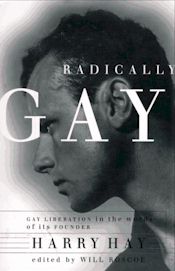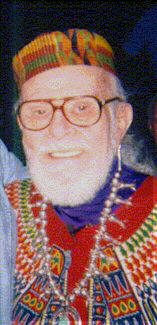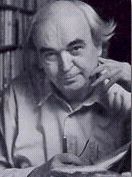 |


|
|
Gay Liberation in the Words of Harry Hay Edited by Will Roscoe International Gay & Lesbian Review About the Reviewer: Jim Kepner was founder of the International Gay and Lesbian Archives, and co-founder of ONE Institute. A major pioneer of the Gay movement as well as a founder of Gay Studies, he died in 1997. His most recent book is Rough News and Daring Views: Pioneer Gay Press Journalism in the 1950S, published by Haworth Press. This review was published posthumously by the ONE Institute. Radically Gay: Gay Liberation in the Words of Harry Hay Edited by Will Roscoe. Beacon Press, paperback edition 1997, 352 pages, $16  These comments on the writings of Harry Hay are based on my personal involvement in the movement that by 1969 began to be called Gay Liberation.
These comments on the writings of Harry Hay are based on my personal involvement in the movement that by 1969 began to be called Gay Liberation.
Back in August 10, 1948, at a meeting near the USC campus in Los Angeles, Harry Hay first suggested a plan that remained stillborn until November 11, 1950, when five men in the Silverlake / Echo Park district of Los Angeles laid surreptitious plans for a revolution. In a time of great repression, oversimplified in memory as the McCarthy era, they projected an organization of homosexuals aimed at relating that cause to other progressive causes. It took five months to come up with the name Mattachine Society and another year for the group to grow much beyond the founders and a few friends. It took 18 more years for what they launched to evolve, with many disjunctions, into what exploded as the Stonewall riots in New York City. Three months after April 1951, when they chose the name Mattachine, I moved into a house a few blocks from the separate homes of three of the founders. During twice-weekly gatherings at my house, I often called a few of those present aside to discuss the need to start a gay organization or magazine, continuing discussions I'd had eight years earlier in San Francisco. My suggestions got nowhere, and when I began to hear about Mattachine, my late-night work schedule prevented me for many months from getting to any of the discussion groups--and no addresses were given out for interested persons to contact. I only found the Post Office box Mattachine had used after I retained one for the reorganized society in Spring 1953. Dynamic Harry Hay has led an amazing life, with experiences that could well fill a dozen other lives. Stuart Timmons did an admirable job in his biography of this extremely complex, inspiring, often prickly and self-important man, The Trouble With Harry Hay, even though space considerations crowded out much that was interesting or important--and having a living subject glaring over the biographer's shoulder is never easy. This is a book which the worshipful but independent thinking Will Roscoe has well edited. As Roscoe says, it is lamentable that so few gays know about the founders of the American movement of which they are beneficiaries--but he also laments Hay's apparent inability to write clearly.
During the life of what Hay calls the First Mattachine (April 1951 to April 1953), Hay admits he could generally outtalk and bamboozle the other founders. Dale Jennings disagreed openly with most of Hay's fundamental philosophy, as did Martin Block. The much more pragmatic Rowland accepted parts of Hay's theory, but in his radical background, he'd learned how to avoid jargon and translate obtuse ideas into language others could understand. Rowland, along with Bob Hull (first of the founders I became acquainted with), Conrad Stevens and Jim Gruber lived in a duplex in Norwalk, an eastern suburb of Los Angeles, and formed the organizing center of Mattachine during its period of lightning growth from Spring 1952 to Spring 1953. Increasingly they turned off on Hay's grand metaphysics and his tendency to dismiss the newcomers as mere "ribbon clerks." The newcomers were a much more diverse group than that, socially, culturally, professionally, politically and religiously. Some were inspired by the founders, some mystified, a few were hysterically opposed. Rowland and Hull knew them well and could work with all but one or two. Hay regarded them all as prissy, conservative department store clerks, betrayers of HIS dream. He missed the fact that many of those he looked down on had also long nurtured dreams not totally unlike his own.
This book project has been under way for some time, and I had thought it was to include Hay's papers and speeches from his Communist Party experience, where he was a skilled defender of every twist and turn of the "party line." It does not include those, and, surprisingly, it omits important speeches which Harry delivered to ONE Incorporated and which were printed in ONE Confidential and ONE Institute Quarterly of Homophile Studies, particularly his talk on the origins of Mattachine delivered in January 1956 at ONE's second Midwinter Institute, printed in the book Homosexuals Today, 1956 edited by Marvin Cutler (Dorr Legg); "The Homophile in Search of an Historical Context and Cultural Contiguity," printed in ONE Confidential, August, 1957, excerpted in Dorr Legg's Homophile Studies in Theory and Practice, 238-241; and "The Moral Climate of Judaism at the Time of Judges," printed in the first two issues of ONE Institute Quarterly of Homophile Studies, which I edited. These occasioned great discussion at the time when our young movement was struggling to shape its philosophical approach(es) and are weightier examples of his work than some of the generally shorter pieces included here. Hay, like many another activist, often claims to have invented ideas or terms which were in use long before he "invented" them: 1. Hay claims to have invented the term homophile, which is generally credited to the Dutch physician Von Romer circa 1908 and was widely used in the European movement since at least 1925. Hay has denied knowing about the European homophile movement at the time Mattachine started, yet he has said repeatedly that Austrian refugee Rudy Gernreich, whom Hay counts as his first recruit to what became the Mattachine, frequently warned the other founders against repeating the mistakes (whatever those were in Rudi's mind) that were made by that European movement. 2. Hay counts his invention of the concept of subject-subject consciousness as one of his prime philosophical contributions, but I find the idea only vaguely distinguishable from Martin Buber's "I-Thou" concept, which Harry insists he was unfamiliar with, though I discussed it frequently with him when we were courting in 1963 and loaned him one of Buber's books. 3. Hay claims credit for inventing in 1979 the idea of the Radical Faeries and the ceremony of the faerie circle, yet the term fairy was widely used in rural and urban gay communes from 1968 on, especially by the Iowa collective which launched the publication R.F.D. in 1974 (as well as on the streets of New York a half century earlier, as George Chauncey has excellently recounted). Artist Olaf Odegaard, a member for awhile of the original R.F.D. collective, says he introduced the use of a talisman to pass around in fairy circles, and introduced Hay to the Faerie colony at Wolf Creek, Oregon. Arthur Evans, author later of The God of Ecstasy, led "Faerie circles" in San Francisco in 1973. (Both Hay and his later adversary Mitch Walker insisted that their 1979 concept of Radical Faeries had nothing to do with Evans' concept.)
5. In the Chronology in the back of Roscoe's volume for 1965, Hay says he and his partner John Burnside helped form the Southern California Council on Religion and the Homosexual. I'm puzzled by this. I was elected secretary at SC-CRH's organizing meeting, and I know they were not in attendance. It may be possible they attended pre-organization meetings, but while Hay and Burnside came to later public meetings of SC-CRH, they were never on the Board of Directors as I was. 6. Hay asserts that before Mattachine, homosexuals were thought of not as a class but merely as normal individuals who had done bad things. While some people thought this way, many gays and non-gays thought of homosexuals as a class having specific attributes. In a page 75 footnote, Roscoe asked Hay about the role of women in the early Mattachine. Hay, to whom I'd asked the same question in 1991 as I was preparing a talk to deliver at the American Historical Association Pacific Branch conference, is thoroughly confused or was badly misquoted. He says, "Del Martin and Phyl Lyon, next to Helen Sanders (Helen Sandoz) and Sten Russell (Stella Rush), their counterparts and first Editors of The Ladder, who moved from SF to LA about 1956, were typical of the lesbians who came forward at all during the first decade." I don't understand that sentence at all. None of the four women he mentioned were in the Mattachine early or late, though Martin and Lyon (like me) were made Honorary Members at the Denver Convention in 1959. The only sense in which they were typical of the lesbians in the early Mattachine was that they were all women. Martin, Lyon and Sandoz (usually forgotten) were the first editors of The Ladder, a task which fell to Sandoz and Rush (after other editors) in 1967. Martin and Lyon never moved to LA, and Rush never lived in SF. Sandoz, originally from Portland, OR, moved from SF to LA in 1956 after she and Rush met at a ONE event and became lovers. They served awhile on ONE's editorial and corporate boards and lived together in LA, then in Manhattan Beach and Coast Mesa, CA, until Sandoz's death in June 1987. Some of Ruth Bernhard's fine photographs appeared in early 1954 issues of ONE Magazine. Geraldine (not Geraldean) Jackson, her movement pseudonym, brought me, as Hay says, to my first Mattachine discussion group, but I don't know what he means by saying "her neighborhood name was Betty Perdue." Betty is a common nickname for Elizabeth, and her name was Elizabeth Browder Perdue. He says that "After ONE Mag started, Ann Carll Reid and her lover Dawn Frederick (who became Eve Elloree and ONE's Art Director) with Ann Carll taking over the editorship from Dale Jennings...." From before they came to LA from Michigan until about 1967, Irma Wolf (Ann Carll Reid, or "Corky") and Joan Corbin (Eve Elloree) were lovers. Some musical chairs later, Vicky moved in with Corky and Joan moved a few doors away with Stella Rush, then later briefly with newcomer Wilna Onthank (Dawn Frederick,) who became the Art Editor of ONE Institute Quarterly. Joan moved on to Gingere, and continued for some years to contribute artwork to ONE and Tangents magazines. Hay concludes, "With the exception of 'Boopsie,' who showed up with Hal Call from San Francisco during the gathering of the First Mattachine's rupturous upheaval in April-May of 1953, these are all the women I know in First Mattachine." Bernhard, Betty, Jo Carson and Boopsie (Marilyn Reiger) were among the women involved in Mattachine. Boopsie, secretary of the May 1953 session, was an Angeleno, not a San Franciscan, though she and other insurgent Los Angeles leaders did ally with Call. While the early Mattachine was almost all-male, there were other women involved, at least in most groups I attended after December 1952. A phone call could have cleared up these points. Too many histories of our movement claim that Mattachine and ONE were all-male. As someone who was there from 1953 on, and who knew most of the principals, including Hay, closely, I have picked at several rather small historical inaccuracies, which ought not detract from the book's overall value. Hay is sadly aware that his vision is shared by few gay movement activists, who, with scant philosophizing, are doing practical work in the world today. He shrugs them off as irrelevant hetero-imitators and stands alone like an Old Testament prophet--an inspiring visionary looking backward to an idealized past. |
 © 1997-2000 BEI
© 1997-2000 BEI

 Jim Kepner
Jim Kepner